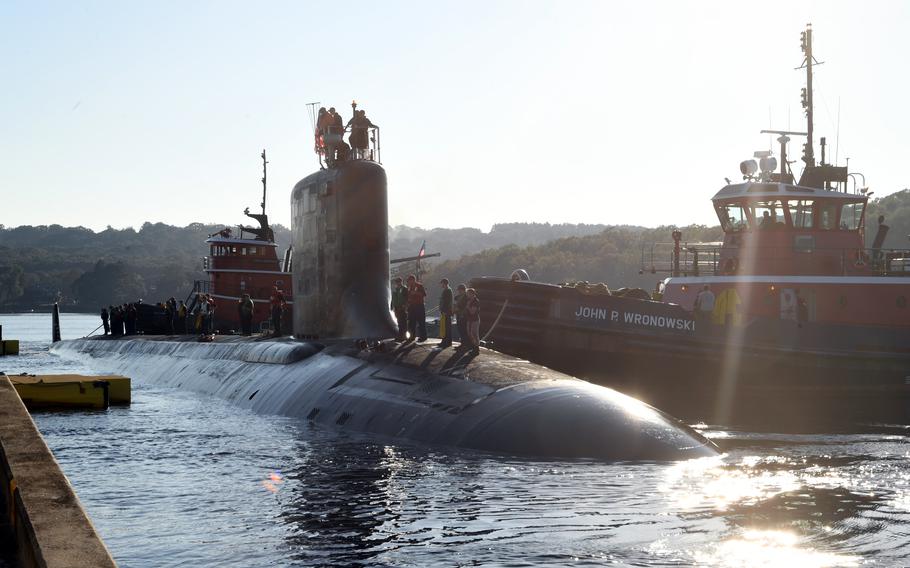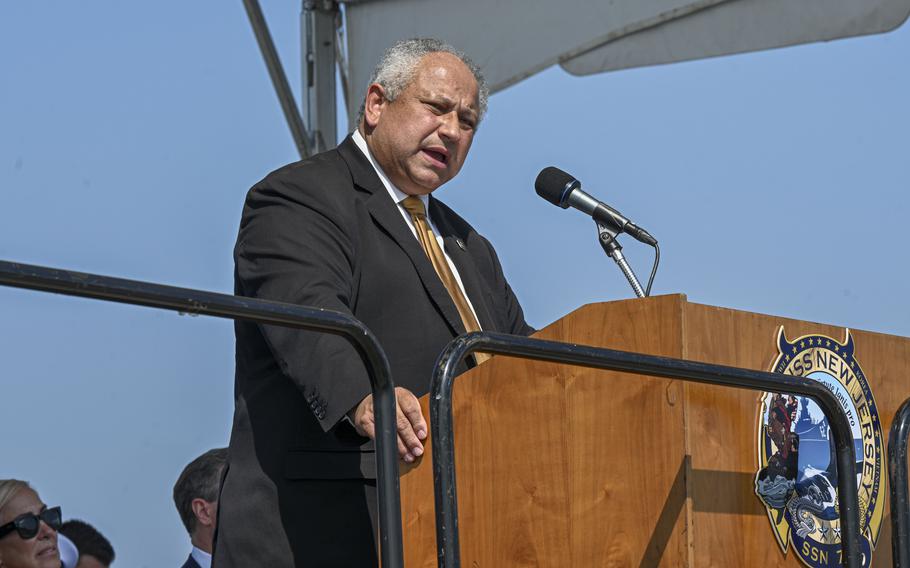
Virginia-class attack submarine the USS Hyman G. Rickover prepares to moor at Naval Submarine Base New London in Groton, Conn., in October 2023. (Joshua Karsten/Navy)
WASHINGTON — Navy Secretary Carlos Del Toro was met with pushback and accusations of withholding information by lawmakers Thursday when he urged them to fill a $1.95 billion gap needed to fund the building of two new submarines.
“I am accountable to the taxpayers, and Mr. Secretary, you are accountable to me,” Rep. Ken Calvert, R-Calif., chairman of the House Appropriations Committee’s defense subpanel, told Del Toro during a closed hearing, according to prepared remarks shared on the subpanel’s website.
The House subpanel and Del Toro held a closed meeting, which Calvert described as an “intervention,” to discuss the near $2 billion budgeting shortfall for two Virginia-class submarines. Lawmakers were notified of the funding gap two weeks ago when the White House issued a list of items needing congressional support if the government is funded by a continuing resolution into the next fiscal year, which begins Oct. 1.
Without support from Congress, construction of the submarines cannot begin during a continuing resolution, according to the White House notification.
“Our submarines truly are the apex predators of the sea, both technically and quantitatively superior to any submarines fielded by our adversaries — principally, our pacing threat, the People’s Republic of China, and our acute threat, Russia. Submarines provide our Navy and our nation a critical, asymmetric advantage — which is why they have and will remain our No. 1 acquisition priority,” Del Toro told House lawmakers.
But Calvert accused the Navy of keeping lawmakers in the dark about the submarine funding shortfalls for months and offering inconsistent information about scheduling delays.
The Virginia-class submarine program, which was on a six-month accelerated schedule, has been delayed two to three years. Beyond the $1.95 billion needed for the two submarines, there is a projected $17 billion funding shortfall across the Virginia-class program for the next six years.
“Somehow, the Navy continues to assert that commitments to [Indo-Pacific Command] and our AUKUS partners remain on track,” Calvert said in his shared remarks. “This causes me to question whether you actually believe your rhetoric on the state of these programs, despite the facts.”
The Navy has a goal to build one Columbia-class submarine and two Virginia-class submarines each year by 2028. By 2032, the pace is planned to increase to one Columbia-class submarine and more than two Virginia-class submarines a year to support a trilateral agreement known as AUKUS between the U.S. and the United Kingdom to build and sell nuclear-powered submarines to Australia.
But the Navy is struggling to construct more than one Virginia-class submarine per year and the Columbia-class program is backlogged three years.

Navy Secretary Carlos Del Toro on Thursday, Sept. 19, 2024, held a closed meeting with House lawmakers to discuss the near $2 billion budgeting shortfall for two Virginia-class submarines. (William Bennett IV/Navy)
Del Toro ordered a 45-day shipbuilding review in January with the goal of identifying causes of shipbuilding delays and recommending actions to keep new builds on schedule. A one-page fact sheet released in April showed several of the Navy’s top shipbuilding programs are one to three years behind schedule.
The fact sheet offered little insight into the cause of the delays, only summarizing bullet points of challenges, which included design issues, first-of-class obstacles, transition to production and design workforce. Class issues included acquisition and contract strategy, supply chain, skilled workforce and government workforce.
Del Toro’s January order blamed the “lingering effects of post-pandemic conditions” on shipbuilders and suppliers, specifically with the Columbia-class submarine and Constellation-class frigate programs.
Since then, the Navy has proposed restructuring how it pays for submarine and aircraft carrier workers in a pitch called Shipyard Accountability and Workforce Support, or SAWS, according to a report by U.S. Naval Institute. SAWS would separate payments for shipyard workforces based on laborers who work on specific hulls, such as welders and pipefitters, and support services shipbuilders, such as supervisors and crane operators who work across a yard. The arrangement could prevent labor-related cost increases to the submarine programs.
“I am skeptical that either will successfully get these fiscal year 2024 Virginia submarines under contract,” Calvert said, referring to the $1.95 billion funding request and the SAWS proposal.
The shipbuilding programs, he said, are in crisis, locked into “a toxic cycle” of lack of information from the Navy, the failure of shipbuilders to urgently resolve issues, and the resulting inability of Congress to conduct informed analysis.
“For too long, this committee has been put in a position of asking what the Navy is hiding behind the curtain — it’s time to pull down the curtain altogether,” Calvert said.
The House subpanel was scheduled to meet with shipbuilders Friday to continue discussions.
“This subcommittee is a strong supporter of the Navy, in particular our submarine programs. The Columbia-class submarines will host 70% of our nation’s nuclear deterrent. The Virginia-class submarines are the lynchpin of our strategy to outmatch China,” Calvert said. “However, submarines and ships only contribute to the fight if they actually exist — not just on paper.”